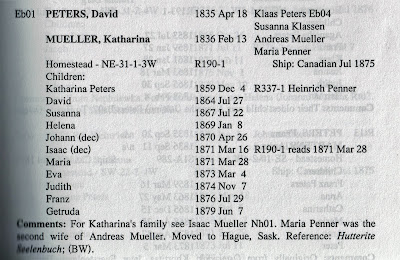52 Ancestors in 52 Weeks
Week 17
Prompt – Land
Mennonites always seem to be on the
move. Prussia to Southern Russia to United States and Canada (and
in my family's case moved from Manitoba to Saskatchewan) to Mexico
and Paraguay.
As I have discussed before the
Mennonites left Prussia for Russia at the invitation of Catherine The
Great. The Mennonites wanted land for their colonies. They were
looking to leave the increasing pressure to military service of their
young men. Along with the need for more land for their grown
children. For more than a 100 years Southern Russia was the promised
land for the Mennonites. In the 1870's things changed. It was
called “Russification”. Slowly their privileges were rescinded.
Their young men were conscripted. The autonomy of education in their
own language was replaced with compulsory education in Russian
language.
In the 1870's Canada was opening up the
west and looking for settlers. Mennonites were known as industrious
and successful farmers. Negotiations began and promises made to the
Mennonite delegation. Canada gave them military exemption, religious
freedoms, self governance of schooling their children. Most
importantly Canada gave them the large tracks of land on which to
settle.
In an article by the Global Anabaptist
Mennonite Encyclopedia Online (GAMEO), it tries to explain this
balance of governance, church and community in settling Manitoba in
the 1870's.
“Because the government decided that a hamlet
had to have a minimum of 20 householders, original villages normally
contained 20 farmyards, 10 on each side of a central street, with 20
quarter-sections (160 acres [65 hectares] per quarter-section) of
land surrounding the village. Each quarter-section was legally
registered in the name of one of the householders, but the village
and the land within the 20 quarter-sections was divided according to
the traditional pattern of a street village (Straßendorf),
a large common pasture, and long narrow strips of land (kögel)
upon which crops were grown. This redistribution of land generally
had no basis in law, but was undergirded by the authority of church.
In those areas where church authority broke down or where churches
split, the villages frequently disbanded. In Manitoba a tension was
thus established between the wishes and the legal rights of the
individual on one hand, and the good of the community on the other".In 1874 the first of the Mennonites immigrated and settled in what was called “The East Reserve”. Quickly many Mennonites became aware that the land in this area was not as fertile as first thought. By 1875 "The West Reserve" was established. Some of the East Reserve Mennonites moved to it, but mostly it was settled with the new immigrants coming to Canada.
David Peters, my paternal great grandfather was a
Mennonite immigrant that landed in Manitoba on July 1875. His family
settled in the colony of Ebenfeld in The West Reserve. Between 1874
and 1880 nearly 7000 Mennonites settled in Manitoba. In 1880 the
first census was taken.
In the book 1880 Village Census Of The Mennonite West
Reserve; edited by John Dyck and William Harms, I have found some
very specific information about David Peters.
These are taken from the church books
and consolidated and transcribed into the Reinlander Gemeinde Buch,
(or Reinlander Church Book). Note “Eb01” to the left of David
Peters name. This was taken from the first church book of the
Ebenfeld Colony. David and Katharina are listed with their date of
births and their parents names to the right. Also it lists their
children, birth dates and in two cases their spouses. It notes that
this clan came over on the ship Canadian and arrived in July of 1875. David Peters' homestead designation is listed. NE-31-1-3W. Northeast
quarter in the 31st section of township 1 and range 3 West
of prime meridian.
In another book called 1880 West
Reserve Census I found the following information which was surprising
in its detail.
Note that David Peters is in Lot 1 of
the village of Ebenfeld.
In the same book is the taxation
records of 1881 of the same colony. This is not a great copy however
it shows David Peters has 30 acres of cultivated soil and 130 acres
of unbroken land. 160 acres is a quarter section of land. David has
no buildings on his land but has two oxen, two cows, two heifers,
four hogs, one wagon and one plow. David's total tax assessment on
this was $340.00. So even though they lived communally they had
taxes based on individual properties.
 |
| Red Square is Homestead Location. South of Winkler and Plum Coulee. |
David Peters' homestead certificate and location of same, based on the land information. This now explains to me why a Mennonite would have a homestead
certificate. I just assumed that since the colonies were communal
that no one individual would have land assigned to them.
David and Katharina only stayed on the
Manitoba West Reserve for a short while. They move on to the new
reserve for Mennonites in Hague-Osler region of Saskatchewan; although
at the time of settling it was still considered North West Territories. I have
not looked up a Saskatchewan homestead certificate for David Peters.
I am sure the story will continue.
Wendy








No comments:
Post a Comment